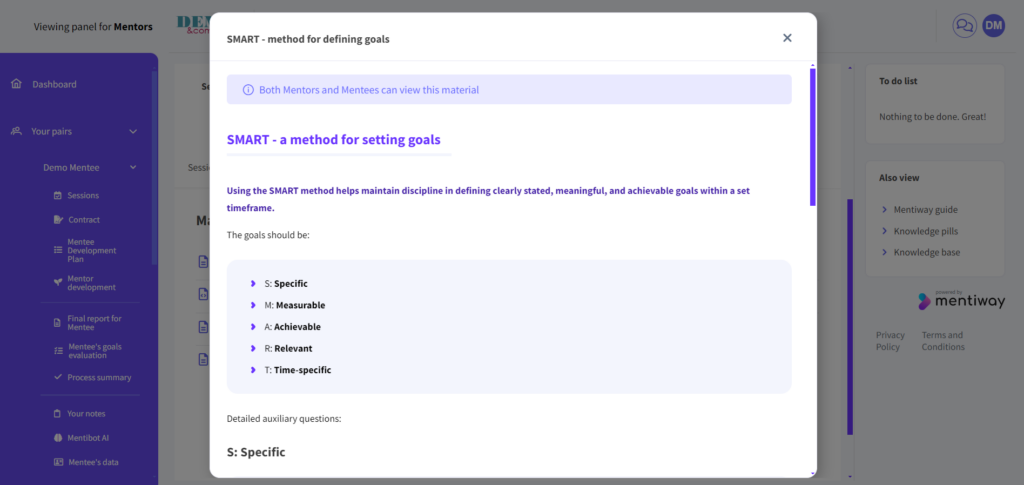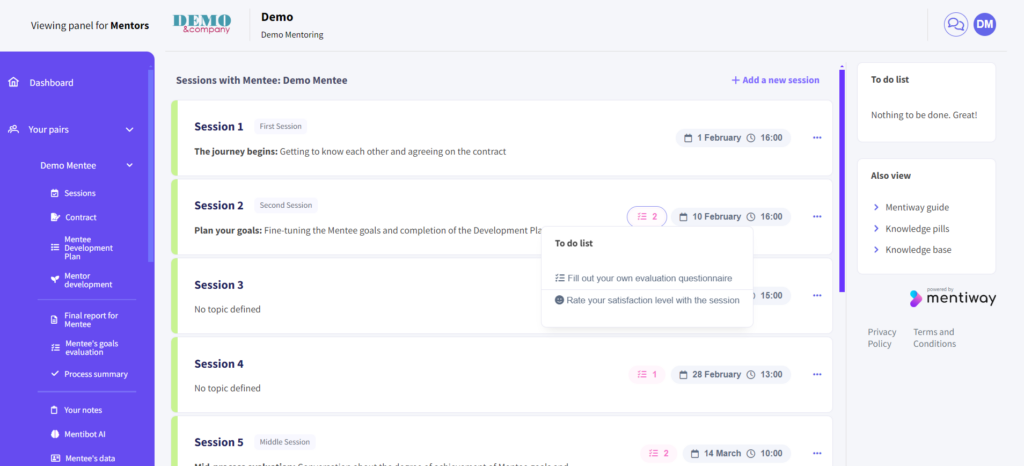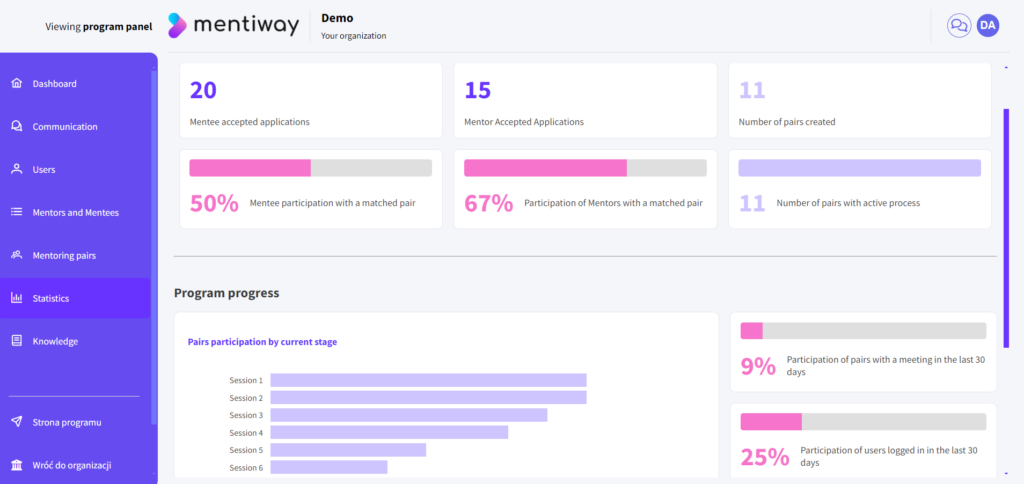Internal mentoring in a company. How to implement a mentoring programme?
Internal mentoring programmes are cyclical, time-limited processes in which mentoring pairs are created between employees of an organisation. Their implementation in companies solves many problems. Among other things, it builds relationships, gives a sense of belonging to a team, not to mention, of course, development – and that of both Mentees and Mentors.
However, in order for mentoring to work properly in an organisation and to achieve these goals, it is necessary to ensure that it has a proper methodology – its implementation and evaluation . There is nothing worse than ‘going for broke’, giving participants freedom to act and then finding out that mentoring does not work.
Below are the key elements of implementing a model mentoring programme in a company according to the methodology we use at Mentiway. It is, among other things, by taking care of all the aspects in the list below that mentoring is so effective in achieving its objectives.
Steps in implementing a mentoring programme in a company
- Selection of the programme manager
- Definition of programme objectives
- Education of potential participants
- Recruitment of Mentors and Mentees
- Bringing participants together in mentoring pairs
- Training and implementation workshops
- First meetings
- Mentoring sessions
- Evaluation of the process
- Completion of the mentoring process
Selection of a mentoring programme manager in the organisation
Before going into the details of the programme itself, it is necessary to identify the person who will manage the whole mentoring process in the company. Very often, this is the person responsible for employee development: an HR employee, a training and development specialist and sometimes the manager of the particular department where the programme is being implemented.
In the case of the implementation of mentoring in a company, in addition to operating a dedicated tool, the programme leader will have responsibility for communication, receiving Mentors’ and Mentee’s requests, implementing them and subsequently responding to questions and problems. An important responsibility of the manager is also to monitor the process and collect feedback from the participants and at the end of the programme to summarise it.
Hi, my name is Thomas. I am the Co-Founder of Mentiway. We are happy to share our knowledge and support organisations on their way to success! 💪 If you are interested in how to efficiently and effectively implement a mentoring programme in your organisation using technology:


The Mentiway application automates most of the processes, provides the knowledge and collects the necessary information itself. In this case, the role of the person focuses on just communicating with participants and solving their problems, removing the burden of organising the entire process
It is also sometimes the case that organisations choose to work with external consultants with expertise in this area to run the mentoring programme. In such a situation, in addition to the above-mentioned tasks, dedicated training and workshops for participants are most common.
Defining the objectives of the mentoring programme
Even before mentoring in an organisation, it is also necessary to define a number of its parameters. The most important of these is the very purpose of the programme and the target group of participants.
Importantly, the goal should have measures of achievement and the organisation should ask itself by what it will know that the programme has been successful.
In addition, the purpose of mentoring should be known and widely communicated to the entire stakeholder group. It is worth paying attention to ensure that mentees’ individual goals fit in with the organisational goals so that both stakeholders benefit.
There are many different types of mentoring, and even among these types it is necessary to choose which areas the programme will highlight and develop.
Types of mentoring programmes in companies:
- Classical – in its basic form, the aim of mentoring is to build a relationship and develop the Mentee and Mentor mainly in soft skills – related, for example, to team building or competences in communication, problem solving, etc.
- Specialised – sometimes a form of mentoring is also used to develop specialised skills, in a specific area – usually related to a broad area of activity in the organisation. An example would be the development of skills in a particular technology in IT companies.
- Reversed – is a fairly recent form of mentoring, usually aimed at developing digital competences. In this case, it is usually people with more general experience who are Mentees and younger, less experienced people who are Mentors. Usually, this form of mentoring allows for the development of competences that are new to the market – for example, activities in social media, related to the Internet and new technologies. See more about reverse mentoring – intramentoring.
- Onboarding – it is very common to use a buddy-ego position to introduce new employees to the workplace. In this case, it is good to formalise this type of relationship precisely by implementing mentoring methodologies.
- Momboarding – is a special form of onboarding where mentoring helps mothers return to work after maternity leave.
The choice of the type of mentoring in an organisation is, of course, based on the group to whom such mentoring will be directed. Here it is also important to outline the competency areas in which the programme will operate. This involves selecting the competencies that will be desired for development by the Mentee and in which the Mentors have experience. An example would be managerial competencies such as team management, conflict resolution, motivation, etc.
Education of potential mentoring participants
Once the mentoring programme has been designed in a company, we should ensure that it is properly ‘advertised’ within the company. It is worth ensuring that all potential participants know about the launch of the programme and can decide whether they want to take part.
It is necessary to explain to the team what mentoring is, what such a relationship consists of, outlining the benefits of participating in the process for both Mentors and Mentee. A set of guides for both groups of participants is also useful here to help them decide.
At Mentiway, this stage of the process is implemented through dedicated landing pages – landing pages that introduce the mentoring programme, ‘advertise’ it internally within the organisation and answer frequently asked questions through a FAQ section. These pages can be open to all or have restricted access – only for employees of the organisation. Presented in this way, the programme is more accessible and thus it is possible to reach almost all employees of the company as widely as possible.
Recruitment of Mentors and Mentees in the company
Once knowledge of the mentoring programme has been provided, the recruitment of participants can begin. Most often, this stage is carried out using online forms that collect data in one place and allow standardisation of applications.
By design, the forms contain different questions for Mentors and different questions for Mentees. Mentors are asked about their experience, knowledge, what they can and want to share with Mentee. The latter, on the other hand, should be asked about their challenges and individual development goals. The questions should enable an appropriate pairing of participants, but also provide a basis for first conversations to check that there is agreement between Mentor and Mentee.
The Mentiway platform automatically generates the application forms for the mentoring programme and presents them next to the online information pages. The questions have a recommended form, but it is also possible to add your own questions or shorten the forms. All answers are later visible to participants in the form of Mentor and Mentee business cards, available at any time during the mentoring process within the organisation.
Creating mentoring pairs
Matching participants into mentoring pairs is one of the most important and also the most difficult stages of a mentoring programme. Mentors and Mentee in their pairs will be working for the next few months, so it is worth taking the extra time to develop the right matching algorithm.
In this case, we basically have two options for action:
- Top-down’ pairing – involves the creation of pairs from the participants by the programme managers. This allows for better management of all participants and, sometimes through compromises, appropriate matching of all Mentees with the right Mentors. However, this is a very time-consuming process, fraught with the risk of error and subjective assessment by the programme leader. Such a solution may result in dissatisfaction among the participants.
- Mentee selection of Mentors – in this case it is the Mentee who selects their Mentors from a list of available people. They see their questionnaires and, based on this, select the people they feel will best suit their development needs.
In developing the Mentiway platform, we have spent a great deal of time developing the best possible algorithm. Based on the experience of many companies and organisations, we have created a model that allows Mentee to choose Mentors, but narrows and sorts the list of available people based on an advanced algorithm using elements of artificial intelligence. This allows the Mentee to choose from among the people best suited to his or her needs and objectives defined at the programme recruitment stage.
In addition, the idea of zero meetings can be used as an option. Mentees have the opportunity to make appointments with a few selected Mentors for short meetings of several minutes in which, according to the advice we suggest, they get to know the Mentors and, on this basis, finally make their choice.
Workshops and training for Mentors and Mentees
Apart from the mere selection of pairs, the effectiveness of the mentoring programme also depends on the commitment and the right approach of both Mentors and Mentee. It is therefore worth taking the time to properly introduce participants to the principles and methodology inherent in mentoring.
Dedicated training courses and workshops are often used for this purpose. Participants should learn about the phases of the process, the principles of collaboration, the tools and techniques they can use when mentoring in the organisation. It is also important to properly guide Mentees in terms of their proactivity and initiative, and Mentors in terms of appropriate behaviour such as, for example, not judging the Mentee’s actions, avoiding giving direct advice, etc.

In the Mentiway platform, each participant gets access to our knowledge base. In it, we have prepared more than 50 training materials – from assignments, exercises and self-reflection surveys to what we believe are the best development and coaching tools and techniques.
In addition, we have powered the platform with a proprietary system for automatic knowledge dosage – Mentibot – which conducts automatic communication with participants giving tips and tools as the process trickles down. In this way, Mentors and Mentees are gradually introduced to the process and at any given moment receive the portion of knowledge they just need.
First meetings – Mentee contract and development goals
Mentees have already met their Mentors, everyone knows the rules of the programme, so it is time for the first meetings.
The first two sessions are particularly important as they lay out the further relationship and collaboration as a couple.
The first meeting should allow the participants to get to know each other better. Mentee then talks about his/her current responsibilities, challenges, development history and plans for the coming year or several years. The Mentor, in turn, talks about his/her experiences and competence areas, placing particular emphasis on those areas where the Mentee has a problem or wants to develop.
The first mentoring session is also an opportunity to confirm the rules that will be appropriate for subsequent meetings, including the very important principle of confidentiality. A contract formula is used for this purpose. This is usually a PDF with written down general principles – such as just the principle of confidentiality and other agreements of the participants.
The first mentoring meetings are also the time to talk about development goals. This is an extremely important stage and what is established there will be the frame of reference for all the activities undertaken as part of the programme.
Mentiway suggests what a contract should contain and also gives tips on how to effectively work out goals.
Mentoring sessions
You could say that it is the actual part of the process, the Mentors meeting with the Mentee. This is where the magic happens. As part of the session, the pairs work together to set goals for each subsequent meeting, work through the Mentee’s challenges, discuss situations the Mentee has found themselves in. Assignments and homework for the Mentee to complete are also often used.

The Mentiway platform ensures that meetings are as productive as possible. Mentibot continuously feeds participants with knowledge and tools to use, and the app itself provides functionality for planning meetings, setting their objectives, recording homework. At important moments, the app also draws attention to selected elements of the process, guiding participants even more effectively through the programme. For example, in the first sessions it reminds of the Mentee’s contract and development goals.
We have also equipped the platform with a self-reflection module – for both Mentors and Mentees. Your own observations, written down after the meetings, allow you to better assimilate knowledge and experience from the sessions. One can also return to one’s own notes later in the process or afterwards. For Mentors, self-reflection is particularly important as it enables conscious development in the role of coach/mentor and provides a basis for further building of these competences – for example through accreditation with EMCC.
Evaluation of the mentoring process in the organisation
Although mentoring is a somewhat autonomous process that is carried out independently by the mentoring pair, it is still worth monitoring to make sure it is going as intended.
The tool that makes this possible from the Mentors’ side are the intervisits and supervisions – i.e. individual and group meetings conducted by accredited supervisors. During these meetings, Mentors discuss difficulties in conducting the process and solve problems.
In addition to this, in a way, contact with the Mentee is also an evaluation tool – either enforced – asking for feedback, or resulting from the Mentee’s needs, signalling, for example, the occurrence of problems.

Mentiway furthermore provides a number of additional tools and functionalities to monitor the mentoring process more closely. Based on current data from the platform, as well as surveys and a satisfaction survey, we provide programme administrators with information on the progress of the programme, such as:
- Process progress, sessions delivered and participant engagement
- Degree of achievement of the Mentee’s objectives
- Satisfaction of Mentors and Mentees with the process in individual sessions
- Quantitative parameters for the declarative development of Mentors during the process
All this information, in aggregated form, is visible in a special reporting dashboard for the mentoring programme manager.
Completion of the mentoring process
At the end of the process, each mentoring pair should take stock of what they have achieved so far, including by assessing the degree to which the objectives have been met, as well as their own reflection and giving themselves feedback on the whole process.
The programme should also be summarised by the manager. This is important from a business and team development perspective. It is necessary to summarise what the implemented programme has given the organisation and whether it is worth pursuing in the future.
Mentiway collects feedback from participants at the end of the process and prepares both individual summaries – for example, in the form of a self-reflection diary for Mentors and Mentees – and a summary of the entire programme taking into account the degree to which objectives have been met, participant satisfaction and an assessment of their development.
Hi, my name is Thomas. I am the Co-Founder of Mentiway. We are happy to share our knowledge and support organisations on their way to success! 💪 If you are interested in how to efficiently and effectively implement a mentoring programme in your organisation using technology:








